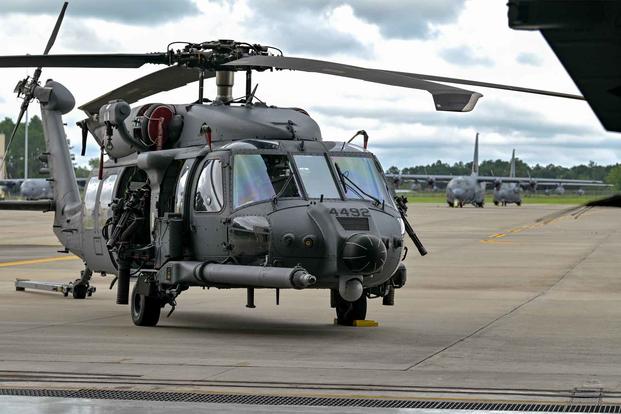The Air Force's new HH‐60W "Jolly Green II" helicopter is heading on its inaugural deployment as Air Force leaders continue to debate how many of the aircraft it will buy.
The deployment comes a month after it was used for its first-ever rescue mission to help an airman in Florida.
Details of the deployment being undertaken by airmen from the 347th Rescue Group from Moody Air Force Base, Georgia, were not shared by the service, but the base bragged about the "first-ever deployment" in a brief Facebook post on Wednesday.
Read Next: Army's Historic WWII Training Grounds Named America's Newest National Monument
"The future of AF Rescue is secure, and our team is ready to recover anybody, anytime, anywhere, against any adversary," 23rd Wing commander Col. Russell Cook said in the post.
The HH-60W, built by Connecticut-based Lockheed Martin-Sikorsky, is the service's updated replacement to the aging HH-60G Pave Hawk search-and-rescue helicopter, and its deployment is a notable achievement after being first tested out by the Air Force in 2019.
The Air Force originally planned to purchase 113 HH-60Ws, but cut that number down to 75 in its 2023 budget request, according to Breaking Defense. Air Force Secretary Frank Kendall told reporters during a roundtable on March 25, that the withdrawal from the Middle East and the focus on adversaries such as China shifted some priorities.
"The scenarios that we're most worried about are not the same as they once were," Kendall told reporters in the briefing. "When we were doing counter insurgencies, and we were losing pilots in those kinds of situations, the needs were different. Acts of aggression like we're seeing in Europe or we might see in the Pacific, the pacing challenge, put us in a very different scenario from a combat rescue point of view."
Current 1980s-era HH-60G models fly low and have a retractable in-flight refueling probe and internal auxiliary fuel tanks that allow for better range during rescue missions.
The HH-60W doubles the internal fuel capacity without auxiliary fuel tanks and increases the flying time. It also has improved avionics, navigation, communications and an enhanced software network, plus better defensive measures and armored plating, according to the company.
"It's an exciting day for Combat Rescue as we bring a new platform and its upgraded capabilities into operation," Maj. Gen. David Lyons, director of operations at Air Combat Command, said in a press release. "This declaration is the culmination of years of hard work and vision.
The HH-60W's first real-time operation happened just a month before it was deemed ready for deployments.
On Sept. 7, South Georgia Medical Center just outside Moody Air Force Base requested assistance for a patient transfer to Moffitt Magnolia Center in Tampa, Florida, about 230 miles away, according to a press release from the base detailing the rescue.
About 40 minutes after the call came in, the HH-60W took off from Moody Air Force Base and landed on a soccer field between South Georgia Medical Center and Valdosta State University's softball diamond. Pararescuemen quickly jumped in an ambulance on the pitch and drove to the hospital to pick up the patient -- an airman from the base's 75th Fighter Squadron.
After getting the patient and "dodging bad weather the entire way," the HH-60W crew landed at a soccer field in Tampa where the patient was loaded into another ambulance and taken to Moffitt Magnolia Center, according to the press release.
-- Thomas Novelly can be reached at thomas.novelly@military.com. Follow him on Twitter @TomNovelly.
Related: Air Force Begins Live-Fire Testing on New Helicopter, Jolly Green II













